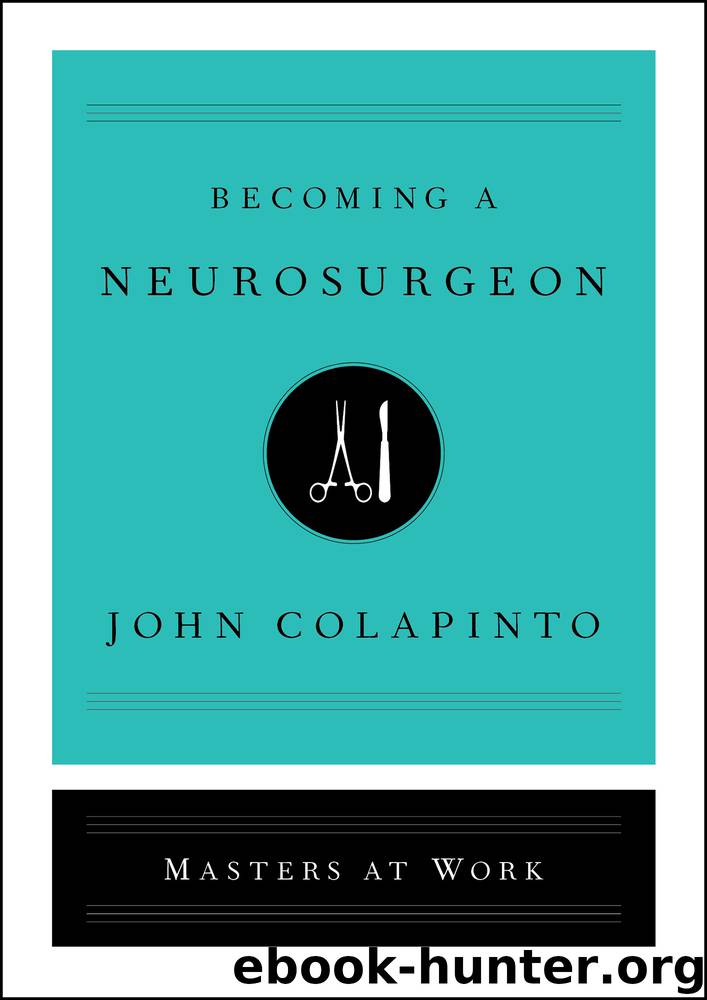Becoming a Neurosurgeon by John Colapinto

Author:John Colapinto
Language: eng
Format: epub
Publisher: Simon & Schuster
For several minutes he explores, very gently moving healthy brain tissue out of the way with retractors and pulling away at the tumor until a movement of his forceps uncovers another glint of whiteness amid the blood and tissue.
“Now,” he says, “there’s the opposite optic nerve—right where it’s supposed to be.” This nerve, running from the right eye, is fully engulfed in tumor. “He’s almost blind in that eye,” Bederson says.
He pushes lightly on the section of tumor that lies between the two optic nerves.
“Feels like foam rubber—bouncy. See, the tumor itself is pulsating. That gives you some idea of the vascular supply within it. Let’s cut into it. Usually it’s not pleasant.”
He gently slices the tumor with a short-bladed scalpel, opening a tiny incision in its surface. Blood gushes from the cut and wells up in the wound. Bederson calmly sucks away the blood, then stanches the bleeding with cottonoids—small pieces of absorbent cotton—and a coagulating foam that he dispenses into the wound. He then uses a pair of cauterizing bipolar tweezers to seal the edges of the cut, administering short bursts of heat through the tips of the tweezers by stepping on a pedal under his left foot. The cauterizing tool makes a loud snapping sound, like corn kernels popping. Gently, carefully, he sucks away at the soft inner part of the tumor that he has exposed with his small incision, debulking it.
Dr. Post, who feels a certain emotional investment in this case—given his earlier role as lead surgeon more than a decade ago and the drama over the canceled operation last week—arrives in the operating room to watch Bederson work. The view through Bederson’s eyepieces is projected on several 2-D screens mounted around the room, including on the base of the intra-operative microscope. Post watches this screen as Bederson places the end of an ultrasound wand against the exposed right carotid artery, one of two major blood vessels that carry blood from the heart, nourishing the brain. The room fills with the rhythmic whooshing sound of the patient’s blood thrumming through the artery.
“Doesn’t sound like a nerve,” Post jokes.
“Yes,” Bederson says. “Let’s stay out of that.”
Post is unable to resist a pedagogic observation for his former underling. “That carotid is closer than you think,” he tells Bederson. “It’s good you’ve got it mapped out. That 3-D view in your mind is going to be precious.”
“Ever seen this type of tumor before?” asks Mascitelli, who is standing beside Bederson and watching through the second set of eyepieces on the microscope.
“Yeah,” Bederson says, “but I’m not sure I’ve ever taken one from between the optic nerves before. Kal did it last time.”
He works for ten minutes, silently, gingerly sucking tumor off the right optic nerve, then carefully cutting open a slit in the membrane that sheathes the nerve, in order to reduce the pressure of cerebrospinal fluid that has built up beneath the membrane—a process known as decompressing the nerve. “I’ve gotten the right optic reasonably well decompressed,” he says, at length.
Download
This site does not store any files on its server. We only index and link to content provided by other sites. Please contact the content providers to delete copyright contents if any and email us, we'll remove relevant links or contents immediately.
| Anesthesiology | Colon & Rectal |
| General Surgery | Laparoscopic & Robotic |
| Neurosurgery | Ophthalmology |
| Oral & Maxillofacial | Orthopedics |
| Otolaryngology | Plastic |
| Thoracic & Vascular | Transplants |
| Trauma |
Periodization Training for Sports by Tudor Bompa(8173)
Why We Sleep: Unlocking the Power of Sleep and Dreams by Matthew Walker(6620)
Paper Towns by Green John(5092)
The Immortal Life of Henrietta Lacks by Rebecca Skloot(4528)
The Sports Rules Book by Human Kinetics(4299)
Dynamic Alignment Through Imagery by Eric Franklin(4119)
ACSM's Complete Guide to Fitness & Health by ACSM(3991)
Kaplan MCAT Organic Chemistry Review: Created for MCAT 2015 (Kaplan Test Prep) by Kaplan(3940)
Introduction to Kinesiology by Shirl J. Hoffman(3726)
Livewired by David Eagleman(3686)
The Death of the Heart by Elizabeth Bowen(3554)
The River of Consciousness by Oliver Sacks(3543)
Alchemy and Alchemists by C. J. S. Thompson(3452)
Bad Pharma by Ben Goldacre(3358)
Descartes' Error by Antonio Damasio(3232)
The Emperor of All Maladies: A Biography of Cancer by Siddhartha Mukherjee(3070)
The Gene: An Intimate History by Siddhartha Mukherjee(3050)
The Fate of Rome: Climate, Disease, and the End of an Empire (The Princeton History of the Ancient World) by Kyle Harper(3007)
Kaplan MCAT Behavioral Sciences Review: Created for MCAT 2015 (Kaplan Test Prep) by Kaplan(2941)
